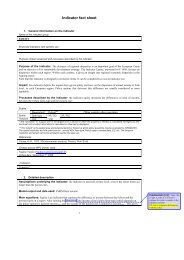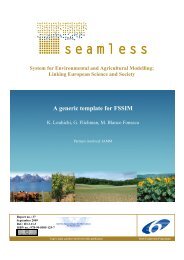Farming Systems Design 2007 - International Environmental ...
Farming Systems Design 2007 - International Environmental ...
Farming Systems Design 2007 - International Environmental ...
You also want an ePaper? Increase the reach of your titles
YUMPU automatically turns print PDFs into web optimized ePapers that Google loves.
<strong>Farming</strong> <strong>Systems</strong> <strong>Design</strong> <strong>2007</strong><br />
Field-farm scale design and improvement<br />
MODELLING FOR INNOVATION IN DESIGN AND CONSTRUCTION OF<br />
CROP PRODUCTION SYSTEMS<br />
G. L. Hammer 1 , D. Jordan 2<br />
1 APSRU, School of Land, Crop and Food Sciences, The University of Queensland, Brisbane, Qld.,<br />
Australia, g.hammer@uq.edu.au<br />
2<br />
Queensland Dept. Primary Industries & Fisheries, Warwick, Qld., Australia, David.R.Jordan@dpi.qld.gov.au<br />
The role of models in innovation has become widely recognised in many fields (Schrage,<br />
2000). Schrage notes that innovative prototypes create innovative teams and treating prototypes<br />
as conversation pieces caters for the complex human interplay required in innovation. This is his<br />
notion of serious play. Hence, model prototyping and simulating are important, but not sufficient,<br />
factors underlying innovation. Focusing on participation of key players, and realising the central<br />
roles of dialogue and co-learning, are equally important factors in the innovation process.<br />
These general concepts have now been largely accepted and adopted in various<br />
approaches leading to the development of improved cropping practices with farmers (e.g. Hammer,<br />
2000; Keating and McCown, 2001; McCown, 2001; Meinke et al., 2001; Carberry et al., 2002;<br />
Nelson et al., 2002). Scientists can bring potential innovation to farming systems practice, but this<br />
must be explored within the context of the real farming system. Simulation-based discussion<br />
provides an effective means to achieve this.<br />
But farmers and their advisers are not the only relevant players in using models as tools for<br />
production system innovation. Hammer et al. (2002) set out a case for the use of models in<br />
understanding genetic regulation and aiding crop improvement. Physiological dissection and<br />
modelling of traits provides an avenue by which crop modelling could contribute to enhancing<br />
integration of molecular genetic technologies in crop improvement (Yin et al., 2004; Hammer et al.,<br />
2005; White, 2006). Models are seen as a bridge between the explosion in capacity and<br />
knowledge in molecular biology and genetics, and its application to plant improvement. Hammer<br />
et al. (2006) and Yin and Struik (<strong>2007</strong>) have recently reviewed the potential for models to help<br />
navigate this complexity and a symposium was devoted to this topic at the most recent<br />
<strong>International</strong> Crop Science Congress (see Cooper and Hammer, 2005). There has been a focus<br />
on ways to quantitatively link model coefficients with underlying genomic regions (e.g. White and<br />
Hoogenboom, 1996; Tardieu, 2003; Messina et al., 2006). It is then possible to incorporate such<br />
gene-to-phenotype models within breeding system simulators to compare breeding strategies<br />
(Cooper et al., 2002; Chapman et al., 2003; Hammer et al., 2005). Attempts to date have<br />
reinforced the need to address the inherent level of detail and quality of crop models for this task<br />
(Hammer et al., 2002; White, 2006). It is becoming clear that enhanced rigour in process<br />
representation, so that interactions and feedbacks are captured correctly, is required for effective<br />
gene-to-phenotype modelling. It is also clear that participatory research and co-learning with plant<br />
breeders, molecular biologists and other players in this field is a key aspect of using models for<br />
innovation in crop improvement programs (Hammer and Jordan, <strong>2007</strong>). Again, the models and<br />
simulations become the discussion piece in seeking innovation.<br />
To date innovations associated with the use of models in crop management or crop<br />
improvement have been incremental. They have been targeted at either management-byenvironment<br />
(M*E) or genotype-by-environment (G*E) interactions. While useful changes have<br />
resulted in agronomic practice (e.g. Meinke et al., 2001; Carberry et al., 2002) and breeding<br />
efficiency (e.g. Campos et al., 2004; Loeffler et al., 2005), progress has been evolutionary.<br />
In this paper we explore possibilities for revolutionary change in cropping systems by using<br />
models to help design and construct novel and innovative production systems. We consider that<br />
new possibilities for simultaneous consideration of genotype-by-management-by-environment<br />
(G*M*E) interactions provide the impetus. It was over a decade ago that Cooper and Hammer<br />
(1996) outlined the concept of fusing the agronomic (M*E) and plant breeding (G*E) perspectives<br />
of crop improvement into a single G*M*E (or G*E*M) approach. They outlined the concept of crop<br />
improvement as a search strategy on a complex adaptation or fitness landscape. The landscape<br />
consists of the phenotypic consequences of G and M combinations in target E. The phenotypic<br />
consequences of only a very small fraction of all possible G*M*E combinations can be evaluated<br />
- 10 -




